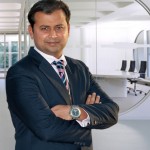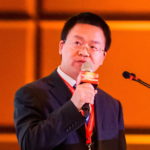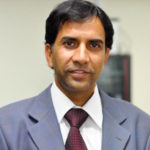Technology offers solutions for more complex problems, say most manufacturers, and consultants, by and large, agree

Kandasamy Anbalagan
VRF technology has stepped out of the shadows of other cooling approaches to secure its position as a strong contender in the region. The positive trajectory that the technology enjoys is confirmed by consultants, such as Kandasamy Anbalangan, Managing Partner, Proleed Engineering Consultants. Based on his experience of working with VRF technology for the past decade, he says it is now widely accepted. “I started doing VRF 10 years back,” Anbalangan says, “where we could not have more than two outdoor units because of space. Then, subsequently, we have introduced VRFs in schools as an addition to existing school [cooling systems]. And now, VRF has been accepted as an alternative to DX and also chillers.”

Tariq Al Ghussain
Tariq Al Ghussein, CEO, Taqeef, highlights the solid position VRF has carved for itself in the industry. VRF, he says, is the natural evolution of the split unit. The introduction of inverter technology with variable-speed compressor, he says, has made existing systems more efficient. The multi-split feature of VRF technology, he adds, allows users to save in capacity and assign particular loads to indoor units, as required, making it more sophisticated with more controls and “proving it is a smarter and more effective split unit”.
“The technology of VRF,” he says, “competes with chillers, not against split units, because it is [essentially] a split unit, but there are certain applications where VRF is a much better solution.” Al Ghussein says that VRF systems are poised to have some of the market share of split units and some of the market share of chillers, though eventually its impact will most probably be most felt by the latter. “This is because it’s new,” he says. “It’s the fastest-growing sector in air conditioning at the moment, worldwide. When it gets saturated and people are using VRF where they’re best [used], then it will reach a more normal rate of growth.”

Syed Jafar Imam
Syed Jafar Imam, Regional Director, AHI Carrier, echoes this, adding that the UAE has been a frontrunner in terms of specifying VRF technology for specific projects. “If you look at any major development in the past two years,” he says, “all those projects are designed with VRF.” He goes on to say that clients have become more aware about what they want and there has been stronger cooperation among consultants.

Scott Coombes
Despite the great strides VRF technology has made with regard to gaining stronger acceptance in the industry, many people believe there is still a lot of room for growth in the GCC region. This is demonstrated by a study that Scott Coombes, Director, AESG, shared with fellow panellists during the 5th Annual Middle East Variable Refrigerant Flow Conference. “We did a study for RSB, last year,” Coombes says, “and when we look at GFA basis, when we look at 120,000 buildings, VRF is [at] four per cent and air-cooled chillers [is at] 40%. The uptake of VRFs is still slow. When you talk of sustainability point of view, it is very project-specific, and we see VRF systems bridging the gap between a packaged or ducted split and a chiller, but that’s really down to the building size. And in Masdar, with different sustainability aspirations and price, most logical [solution] was VRF for them. And savings were a lot higher.”

Fady Nassar
Fady Nassar, Director of Unitary Business, SKM, presents a more conservative perspective of the VRF market, saying that the forecast of its penetration in the UAE is less than they expected, especially compared to countries such as Iran and Turkey, where, he says, VRF enjoys a penetration of between 60 and 75%. Echoing Coombes, Nassar says that VRF – if specifically looked at from the GCC region context – still has not developed the way manufacturers are expecting. Pointing out that the technology is predominantly from the East – Japan, South Korea and, recently, China, Nassar says that several manufacturers have proved that they have good manufacturing, but it’s not the UAE that’s scoring the highest in VRF. “I was surprised to find out that District Cooling will be number one, water cooling, then DX, and then last is VRF,” he says. “So, in my experience, consultants are still reluctant in areas like UAE, Qatar, Kuwait and Bahrain. Saudi is picking up but, still, it’s not the winning bet.”
So, what’s the hold up?
The lower penetration of VRF technology in the countries that make up the GCC region, compared to other countries, is encouraging manufacturers to look at potential areas of improvement. A number of consultants have shared their concerns with regard to using VRF technology in their projects, which represent bottlenecks towards its
greater adoption.

Hassan Younes
Hassan Younes, Technical Director, Griffin Consultants, touches on an old issue that consultants often have with VRF technology, which is with regard to leakage, saying that compared to chillers, since VRF systems run inside the room, in the event of a leakage the situation could be harmful to people living inside the space. He says that though calibrations could be made, this isn’t often done by consultants or contractors.
Shedding light on a different issue, Juanito H Ingal, Mechanical Engineer, KN International Abu Dhabi, says that KN’s primary interest in learning about VRF technology lies in knowing which products have features that his firm can adopt during the design stage. He also places heavy emphasis on the importance of tailoring design needs. “The supplier decides, depending on the conditions in the Middle East, he says. “You have to adopt it even in the stage of the design development. In each company, it all boils down to the design development, that’s where the new technology comes in, and that’s where they adopt the standards they prefer.”
Ingal also says that the cost of the product is also a concern. He says that from his experience working in Abu Dhabi, since VRF technology has not been explicitly approved or introduced by authorities it is difficult to adapt a technology if it has to go through a registration process. He adds that, often, the problem is also that the designer takes the risk, and it’s no longer the responsibility of the developer.

Jean Van Loggerenberg
Jean Van Loggerenberg, Mechanical Engineer Director, CKR, echoes the issue of the price being a disadvantage, adding that another matter of concern is that “the level of expertise you need in terms of the technicians — is slightly more complicated”. Versatility is the main concern that Ross Mclean, Senior Associate Director, Rider Levett Bucknall, points to,when asked his views on the VRF technology, saying that the main challenge is with regard to the capacity and efficiency of VRF technology for high-rise projects.
Heeding the call
Manufacturers, however, are becoming more aware of both old and new issues, often making a case that while disadvantages continue to be highlighted, advantages are undeniable. As a result, they are being proactive with developing and sharing solutions that will unleash the potential of their respective products, employing the latest technological advancements and smart systems as well as establishing training and support infrastructure to overcome technical challenges and negative perception.

Nabil Shahin
“Some GCC customers are somewhat nervous about this relatively new HVAC product category,” Nabil Shahin, Director of Product Marketing, Daikin, admits. “It is mostly due to the lack of familiarity with VRF. Some tend to believe that it is rigged with electronics and complicated, but at the same time, they understand or hear about VRF’s benefits regarding energy saving, installation and comfort, so customers tend to go with trusted manufacturers to ease their fear.”
Al Ghussein echoes Shahin when he says: “People are afraid of new technology, and they are not aware of new technology. Even if you went on the Internet, you see chiller vs VRF technology. Many are very pro-chillers, but facts speak for themselves.”

Dharmesh Sawant
Companies that have established training programmes are now reaping the benefits, as greater awareness among relevant stakeholders seems to be driving a more cohesive ecosystem and knowledge exchange. Dharmesh Sawant, Senior Manager, LG Electronics, says that recently there has been a lot of interest among FM companies to train their personnel, which he notes, is a vital element in the successful deployment of a VRF system. “One of the major developers,” he recalls, “who is prominent in VRF use, sent their FM personnel for training and for evaluation of their skills on VRFs. At the same time, I request all developers to make it mandatory for their FM guys to get certification.”
“I think VRF is part of the future,” adds Al Ghussein. “We have invested a lot of money [in it], and we have our own training centre. We are training our own people and any contractor or consultant that want to know [about the system]. We invest in our capability in service, in installation, in commissioning, and we will personally test and commission for free, even if we’re not installing it. We also want to teach people how to use [the system] smartly and efficiently, because a lot of features are not being used.”
Shahin also emphasises the technological advancements of VRF technology, saying that VRV [as Daikin calls it] systems are getting more and more integrated with smart home controls. As an example, he shares that Daikin offers a new central control tablet to accommodate not only the VRV AC function but also other devices, such as lighting. “Commissioning is no longer done with dip switches; it is done from the comfort of the technicians’ laptops,” he says. “VRF has detailed diagnostic feedback features that help the service and repairman pinpoint the problems, quickly reducing guesswork and downtime.”
Imam also touches on the importance of such features, stressing that the proper use of the smart applications and systems is necessary for the product’s successful commissioning. This, he adds, alleviates certain issues and addresses the issue of leakage, through both prevention and cure. “In VRF, there is always a piping software,” he says. “Manufacturers make it available, and it suggests thickness of the pipe and size, based on the distance of the indoor to the roof. In VRF, you can’t use cheap-quality pipes, so there are bare minimum requirements – you have to [use] good quality pipes. This is prevention.” The second issue, he notes, is installation and the importance of proper brazing. “If the guy is not doing brazing, the machine will show leakage and gas pressure,” he says. [The machine] won’t allow you to commission. After this, the chance of leaking is not possible, because you use good-quality pipes, as recommended in [the] system and piping.”
Al Ghussein adds to the robust argument presented by Imam with regard to leakage no longer being an issue of concern. “There’s never been an incident in Japan with a gas leak,” he remarks. “When you install a system and pressure-test it, it doesn’t leak, it’s sealed. The system is huge. [For example] one outdoor unit is connected to three rooms; if that leaks, it’s harmless. Unless, let’s say, you decided to do a building in one loop, that’s 100 air conditioners and all the gas of the 100 air conditioners go to that one room and the room is closed. However, now there are restrictions, you cannot have more than a certain number of units in one loop. It [leakage] doesn’t happen. There are no incidents such as these. It’s not dangerous; if it was, such governments like in Japan, would put regulations, but they haven’t. There are only limitations that you cannot connect so many in a row.”

Dick Shi
Dick Shi, Regional Director, Middle East and Africa (MEA), Qingdao Hisense Hitachi Air-conditioning Marketing, addresses the issue of leakage by reiterating his company’s commitment to training. “Leakage,” he says, “is because of the installation. We have strict installation procedure and standards. We pressure-test the tightness to make sure there is no leakage, 600 psi for 24 hours. We have met a lot of installers that only pressure-test under 500 or 450 psi, but our standard is 600 psi. We vacuum the gas, we charge the refrigerant, the working period is over two hours to make sure there is no leakage in the pipe.” In addition, Shi notes that the company has a stringent system across its chain of distributors and stakeholders to ensure all inspections and systems are carried out properly and as per its standards.
Taking a cue from the east

Zhang Wenqiang
While manufacturers operating in the Middle East are eagerly capitalising on the latest technologies and developing campaigns to help educate the market, the East, however, has long accepted VRF technology as a normal part of everyday life. Shi stresses that in China, VRF has transformed into a B2C system, instead of just a B2B system. “The China market for VRF is 40% of the world in value; if you add Japan and Korea, it’s 63%,” says Shi, quoting from a BSRIA study. Shi’s colleague, Zhang Wenquiang, Senior Vice President of Qingdao Hisense Hitachi Air-conditioning Systems, points to how VRF has gained in acceptability as a solution for high-rise towers in China. He says, “In China and Japan, a lot of successful projects in high-rise buildings use VRF, [such as] government buildings, school, hotels, hospital and offices.” He says that this is owing to the company’s proactive efforts at the time of introducing the product to the market. “We spent a lot of time educating and in communication with consultants and institutes, to tell them we can use this in high-rise buildings,” he says. “It takes time, but it can be worthy.”
Shi adds that the growth of construction activity in China has also played a role in this development. “In the last 15 years, China [has] changed a lot,” he says. “There are more cities, more buildings. The Chinese economy relies on real estate a lot. China is the biggest construction site in the world.” This, says Shi, has driven demand for air conditioning and VRF technology.
Shi draws a parallel between China and the UAE, gleaning from his observation of massive projects underway and construction activity across the country. “The UAE is the biggest market in the Middle East for VRF,” he remarks, “and it’s growing; compared with Saudi and Iran, the market share of VRF is bigger.”
That said, speaking specifically about the ‘Made in China’ tag, Shi says that negative perception about Chinese brands, however, is a problem, when overseas. “For our brand, the bottleneck is the branding as well as prejudice and concerns of Chinese products,” Shi says. “The consultant and contractor [have yet] to accept our brand, because it is more famous in China. In other regions, it takes more time to convince them that Chinese brands are as good as Japanese, Korean or US brands.”
Al Ghussein also comments on this issue. “We learn a lot from both our partners, Fujitsu General and Midea, who spends a billion on R&D,” he says. “People are still hesitant, and there is a lot of apprehension. People still think they don’t want Chinese products. However, they are the manufacturers of the world; now they are rebuilding their own brands. I’ve seen how they’ve changed – their products are as good as any.”
Foreshadowing: can VRF’s Success in China be replicated in the Middle East?
With a number of Chinese brands proactively entering the local market, does their move to penetrate the UAE signal the country’s potential to embrace VRF technology with the same vigour as in China? And will the GCC region soon be welcoming the system with the same level of enthusiasm across its high-rise projects? The answer may lie in mindful application and in challenging the status quo.
Providing evidence on the importance of collaboration across the design process, Shi says that in China, using VRF for projects up to 300 metres poses no problem, as people can simply put in another mechanical floor for the outdoor units. “This is planned during the design stage,” he says. “If you need to put VRF, we start from architectural drawings. The architects [in China] are already familiar with VRF systems, so in the initial design they consider location.”
Abdelraheem Sallam, Manager of Engineering Services, Real Estate Operations, Dubai Properties, provides an end-user perspective as he stresses on the issue of design processes across the country. All new project designs coming in for review, he says, contain many mistakes, and most of the consultants are copying from one another. A project, he says, is not tailored according to the needs; [there is] no creativity, no one has the courage to take the risk and do something new. Most copy and paste from one another to be safe.
Coombes also touches on the issue of the “copy-paste approach to design”, saying that it is still prevalent in the region and that some regulation is needed to help in this regard. “If support [is given to] consultants on implementation,” he says, “then VRF can get better traction. If healthier budgets are allocated to design, then VRF could score. Lifecycle-wise also, VRF can be beneficial.”
Al Ghussein further makes a case for VRF in this regard. “There used to be lack of regulation,” he says. “Traditionally, you can buy products that were really inefficient. Also, engineers are used to chillers, which they can install with their eyes blindfolded. Now, there are certain densely packed scenarios, big open spaces like Dubai Mall, where, yes, I would put a District Cooling plant there. District Cooling can be efficient, but if it’s not run or managed well, it’s quite expensive. Also, what about pumping cost and the effect of water – that’s becoming cost prohibitive.” Al Ghussein adds that with the cost of electricity bills coming in higher, more and more people are becoming more conscious of electricity consumption. “In some situations, I would recommend VRF,” he says. “In others, I would recommend the use of split unit. Where VRF has not yet taken off is in high-rises, [but] in 10-20 metres, it is the perfect solution – it saves cost and installation [time].”
On adopting global standards
There has been a lot of discussion on the establishment of regulation and standards in relation to VRF  technology. Dr P R Jagannathan, Manager, Sustainability, Trakhees, says that there is no regulation specific to VRF and that the main focus is on how the technology achieves energy efficiency, which he says, is decided by the stakeholders.
technology. Dr P R Jagannathan, Manager, Sustainability, Trakhees, says that there is no regulation specific to VRF and that the main focus is on how the technology achieves energy efficiency, which he says, is decided by the stakeholders.
The issue of efficiency, however, also leads to a discussion on certification of products, and ensuring their conformity with particular testing standards. In that context, it is interesting to listen to Federico Muñoz Sánchez, Technical Commercial Director of CEIS, which is set to launch the largest European laboratory for the testing of air-to-air equipment, including VRF technology, at Móstoles in Madrid, Spain. “CEIS, as a test laboratory,” he says, “will effectively carry out the evaluation of VRF technologies based on the SEER approach. The SEER approach is, indeed, much more representative of the overall behaviour of a VRF than single standard EER rating.” He says that the laboratory will also be calibrating its tests to address the needs of the Middle East region. “CEIS carries out tests in accordance with the European standard EN 14511-3 and takes into account the partial- load conditions laid down in the European standard EN 14825, which allows the calculation or verification of the performance of the equipment under seasonal conditions,” he says. “However, the new test facility is designed to reach outdoor temperatures of up to 55 degrees C, so that specific weather conditions for the Middle East region can be reached.” He says that since the number of VRF manufacturers are not so high, CEIS, which works closely with Europe-based HVACR association, Eurovent, will be able to utilise its facilities in Spain to address the needs of leading manufacturers in Japan, South Korea and those in the Middle East region.

Federico Muñoz Sánchez
Sánchez says that there is no need to adopt new standards for the Middle East, as those that exist globally would be of use to the region: “We consider [it] fundamental that regardless of the test method used, authorities such as ESMA or SASO, who consider implementing MEPS for VRF equipment, use reference schemes based on those used in other regions of the world. In this sense, we understand that European schemes can be a perfect basis for the development of local schemes.”

Carlos Amaya
Carlos Amaya, Senior Specialist, Conformity Scheme Services – Product Conformity, Abu Dhabi Quality and Conformity Council (ADQCC), is an advocate of the SEER approach to testing VRF systems. “I agree with the European approach, and [it] would be much better,” he says. “As QCC, we can facilitate a working group with ESMA and Eurovent to come up with a roadmap to come up with a seasonal approach.”
Manufacturers and distributors have affirmed their strong belief in the importance of such developments. “Taqeef is keen on working with these bodies,” says Al Ghussein. “We are a member of Eurovent, and we work with QCC to offer any advice we can.”
Al Ghussein speaks of how all the positive talk relating to regulation bodes well for the company’s recent initiative of offering retrofit solutions. “Retrofit [projects] offer a lot of opportunity for VRF.” He speaks of one case study, where the company installed VRF system in a 25-year-old building and requested an independent company accredited by Dubai government to audit the electricity consumption and determine the energy saving. He is optimistic about the possibilities this offers to the retrofit market and confirms the company’s move to further explore this path. This, he says, only further reinforces the importance of third-party standards and tests. “You need to have independent studies,” he stresses, “because there are a lot of doubters.”
Bridging the gap: A step in the right direction
It would seem that VRF technology has all the right tools to succeed and secure greater penetration. The answers to the problems exist, and as more complex issues emerge, more sophisticated solutions are being set in motion, say industry insiders. The issue now, it would seem, is in developing stronger communication channels that will educate relevant stakeholders of the existing solutions.
Overall, a mood of general optimism prevails with regard to VRF technology, and consultants, such as Younes, among others, commend manufacturers for their efforts in making VRF technology more efficient and reliable, noting that there have been many developments in this regard. “I see the VRF market kind of booming,” he says. “A lot of people talking about it, it might have challenges. In some cases, projects might fail in terms of energy if they don’t hit the energy targets they expected. But it’s not one-size-fits-all. In some projects, where VRF wasn’t the best solution, it will show when it’s not working properly, which may lead to clients and consultants being dissatisfied, and it might backfire, and they might think VRF is not a good technology. But, I still think it’s here to stay. It’s adapting to the market, and I see many people using it.”
Jagannathan says that the technology has done all it can to prove itself, and that it is now up to the relevant stakeholders to ensure that VRF technology continues to move in the right direction. “VRF, as such, requires more of a united engineering approach than product approach to convince the consultant,” he says, “or you will end up as BMS, which has been around for long but has been misused.” He issues a careful reminder to manufacturers to remain vigilant, saying, “The onus to prove this system works as good as, if not more than, other systems, lies with you with engineering solutions and installation practices.”
Copyright © 2006-2025 - CPI Industry. All rights reserved.